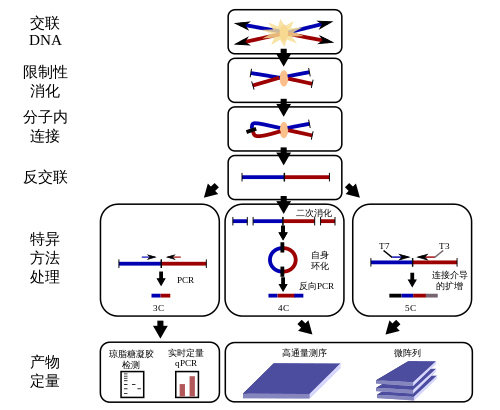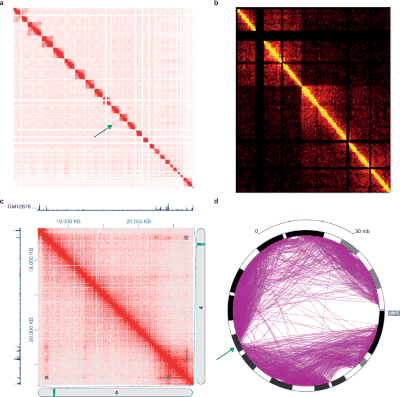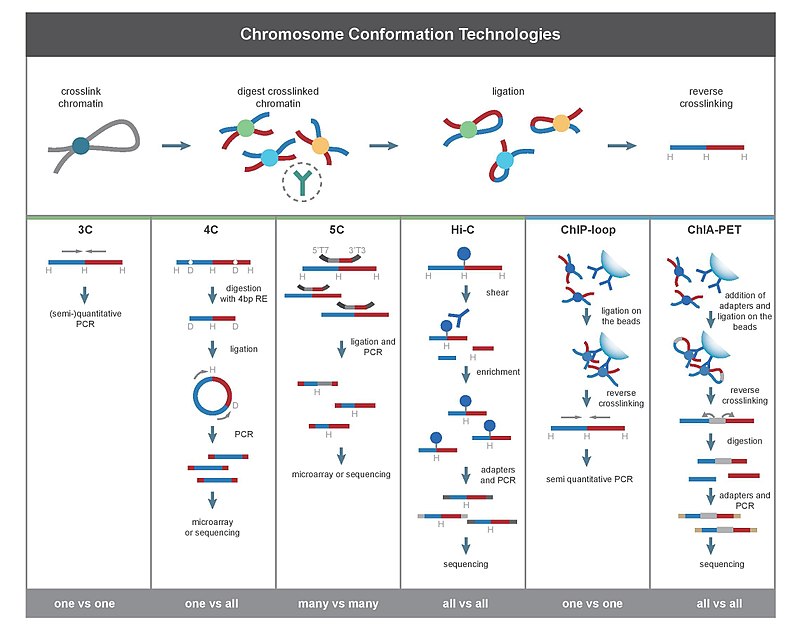染色 体 构象捕 获

历史
[编辑]很久

1879
1883
1884
1888
1889
1928
1942
1948
1953
1961
1973-1974
1982
1984
2002
2003
2006
2007
2009
2012
实验方法
[编辑]

方法 对比
[编辑]3C (one-vs-one)
[编辑]4C (one-vs-all)
[编辑]5C (many-vs-many)
[编辑]Hi-C (all-vs-all)
[编辑]Hi-C
生物 学 意 义
[编辑]3C
3C
这些
人 类疾病 相 关研究
[编辑][
Holoprosencephaly
PPD2(
[
[T细胞
数 据 分析
[编辑]
Hi-C
Hi-C及其
3C
DNA motif分析
[编辑]DNA motifs
Bailey
对于
癌 细胞分析
[编辑]Taberlay
Harewood el. al
Ferhat Ay et al.
罗等
值得
另见
[编辑]参考 文献
[编辑]- ^ Dekker J, Rippe K, Dekker M, Kleckner N. Capturing chromosome conformation. Science. 2002, 295 (5558): 1306–1311. PMID 11847345. doi:10.1126/science.1067799.
- ^ Tolhuis B, Palstra RJ, Splinter E, Grosveld F and de Laat W. Looping and interaction between hypersensitive sites in the active beta-globin locus. Mol. Cell. 2002, 10 (6): 1453–1465. PMID 12504019. doi:10.1016/S1097-2765(02)00781-5.
- ^ 3.0 3.1 Denker, Annette; de Laat, Wouter. The second decade of 3C technologies: detailed insights into nuclear organization. Genes & Development. 23 June 2016, 30 (12): 1357–1382. PMC 4926860
 . PMID 27340173. doi:10.1101/gad.281964.116.
. PMID 27340173. doi:10.1101/gad.281964.116.
- ^
存 档副本 . [2017-12-31]. (原始 内容 存 档于2018-04-22). - ^
存 档副本 . [2017-12-31]. (原始 内容 存 档于2017-12-07). - ^ MARTINS, L.A.-C.P.. Did Sutton and Boveri propose the so-called Sutton-Boveri chromosome hypothesis?. Genet. Mol. Biol. [online]. 1999, vol.22, n.2 [cited 2017-12-07], pp.261-272. Available from: <http://www.scielo.br/scielo.php?script=sci_arttext&pid=S1415-47571999000200022&lng=en&nrm=iso (页面
存 档备份,存 于互联网档案 馆)>. ISSN 1415-4757. http://dx.doi.org/10.1590/S1415-47571999000200022. - ^
存 档副本 . [2017-12-31]. (原始 内容 存 档于2018-01-29). - ^
存 档副本 . [2017-12-31]. (原始 内容 存 档于2017-01-18). - ^ 9.0 9.1 9.2 Deichmann, U. (2016). Epigenetics: The origins and evolution of a fashionable topic. Developmental Biology, 416(1), 249–254. https://doi.org/https://doi.org/10.1016/j.ydbio.2016.06.005
- ^ Lu, H., Liu, X., Deng, Y., & Qing, H. (2013). DNA methylation, a hand behind neurodegenerative diseases. Frontiers in Aging Neuroscience, 5, 85. http://doi.org/10.3389/fnagi.2013.00085
- ^
存 档副本 . [2017-12-31]. (原始 内容 存 档于2019-09-27). - ^ Cremer, T., & Cremer, M. (2010). Chromosome Territories. Cold Spring Harbor Perspectives in Biology, 2(3), a003889. http://doi.org/10.1101/cshperspect.a003889
- ^ Simonis, M., Klous, P., Splinter, E., Moshkin, Y., Willemsen, R., & de Wit, E. (2006). Nuclear organization of active and inactive chromatin domains uncovered by chromosome conformation capture-on-chip (4C). Nat Genet, 38. https://doi.org/10.1038/ng1896
- ^ Dostie, J., Richmond, T. A., Arnaout, R. A., Selzer, R. R., Lee, W. L., & Honan, T. A. (2006). Chromosome Conformation Capture Carbon Copy (5C): a massively parallel solution for mapping interactions between genomic elements. Genome Res, 16. https://doi.org/10.1101/gr.5571506
- ^ Albert, I., Mavrich, T. N., Tomsho, L. P., Qi, J., Zanton, S. J., Schuster, S. C., & Pugh, B. F. (2007). Translational and rotational settings of H2A.Z nucleosomes across the Saccharomyces cerevisiae genome. Nature, 446, 572. Retrieved from http://dx.doi.org/10.1038/nature05632
- ^ Lieberman-Aiden, E., van Berkum, N. L., Williams, L., Imakaev, M., Ragoczy, T., & Telling, A. (2009). Comprehensive mapping of long-range interactions reveals folding principles of the human genome. Science, 326. https://doi.org/10.1126/science.1181369
- ^ Fullwood, M. J., Liu, M. H., Pan, Y. F., Liu, J., Xu, H., & Mohamed, Y. B. (2009). An oestrogen-receptor-alpha-bound human chromatin interactome. Nature, 462. https://doi.org/10.1038/nature08497
- ^ Dixon, J. R., Selvaraj, S., Yue, F., Kim, A., Li, Y., Shen, Y., … Ren, B. (2012). Topological Domains in Mammalian Genomes Identified by Analysis of Chromatin Interactions. Nature, 485(7398), 376–380. http://doi.org/10.1038/nature11082
- ^ Dekker J. Personal communication.
- ^ Hagège H, Klous P, Braem C, Splinter E, Dekker J, Cathala G, de Laat W, Forné T. Quantitative analysis of chromosome conformation capture assays (3C-qPCR). Nat. Protoc. 2007, 2 (7): 1722–1733. PMID 17641637. doi:10.1038/nprot.2007.243.
- ^ Tolhuis B, Palstra RJ, Splinter E, Grosveld F, de Laat W. Looping and interaction between hypersensitive sites in the active beta-globin locus. Mol. Cell. 2002, 10 (6): 1453–1465. PMID 12504019. doi:10.1016/S1097-2765(02)00781-5.
- ^ 22.0 22.1 Cavalli, Giacamo. Functional implications of genome topology. Nature Structural & Molecular Biology. 2013, 20 (3): 290–299 [12 June 2016]. doi:10.1038/nsmb.2474. (
原始 内容 存 档于2013-05-13). - ^ J. Dekker, M. A. Marti-Renom, and L. A. Mirny, “Exploring the three-dimensional organization of genomes: interpreting chromatin interaction data,” Nature reviews. Genetics, vol. 14, no. 6. pp. 390–403, Jun-2013.
- ^ Y. Guo et al., “CRISPR Inversion of CTCF Sites Alters Genome Topology and Enhancer/Promoter Function.,” Cell, vol. 162, no. 4, pp. 900–910, Aug. 2015
- ^ Krijger, P. H. L., & de Laat, W. (2016). Regulation of disease-associated gene expression in the 3D genome. Nat Rev Mol Cell Biol, 17(12), 771–782. Retrieved from http://dx.doi.org/10.1038/nrm.2016.138
- ^ Fritsch, E. F., Lawn, R. M. & Maniatis, T. Characterisation of deletions which affect the expression of fetal globin genes in man. Nature 279, 598–603 (1979)
- ^ Van der Ploeg, L. H. et al.
γ -Β -Thalassaemia studies showing that deletion of theγ - andδ -genes influencesβ -globin gene expression in man. Nature 283, 637–642 (1980). - ^ Jeong, Y., El-Jaick, K., Roessler, E., Muenke, M. & Epstein, D. J. A functional screen for sonic hedgehog regulatory elements across a 1Mb interval identifies long-range ventral forebrain enhancers. Development 133, 761–772 (2006)
- ^ Lettice, L. A. et al. A long-range Shh enhancer regulates expression in the developing limb and fin and is associated with preaxial polydactyly. Hum. Mol. Genet. 12, 1725–1735 (2003)
- ^ Wieczorek, D. et al. A specific mutation in the distant sonic hedgehog (SHH) cis-regulator (ZRS) causes Werner mesomelic syndrome (WMS) while complete ZRS duplications underlie Haas type polysyndactyly and preaxial polydactyly (PPD) with or without triphalangeal thumb. Hum. Mutat. 31, 81–89 (2010).
- ^ Zhang, X. et al. Identification of focally amplified lineage-specific super-enhancers in human epithelial cancers. Nat. Genet. 48, 176–182 (2016)
- ^ Mansour, M. R. et al. Oncogene regulation. An oncogenic super-enhancer formed through somatic mutation of a noncoding intergenic element. Science 346, 1373–1377 (2014).
- ^ Lajoie, Bryan R; van Berkum, Nynke L; Sanyal, Amartya; Dekker, Job. My5C: web tools for chromosome conformation capture studies. Nature Methods. 1 October 2009, 6 (10): 690–691. doi:10.1038/nmeth1009-690.
- ^ Deng, Xinxian; Ma, Wenxiu; Ramani, Vijay; Hill, Andrew; Yang, Fan; Ay, Ferhat; Berletch, Joel B.; Blau, Carl Anthony; Shendure, Jay; Duan, Zhijun; Noble, William S.; Disteche, Christine M. Bipartite structure of the inactive mouse X chromosome. Genome Biology. 7 August 2015, 16 (1). doi:10.1186/s13059-015-0728-8.
- ^ Rao, Suhas S.P.; Huntley, Miriam H.; Durand, Neva C.; Stamenova, Elena K.; Bochkov, Ivan D.; Robinson, James T.; Sanborn, Adrian L.; Machol, Ido; Omer, Arina D.; Lander, Eric S.; Aiden, Erez Lieberman. A 3D Map of the Human Genome at Kilobase Resolution Reveals Principles of Chromatin Looping. Cell. December 2014, 159 (7): 1665–1680. doi:10.1016/j.cell.2014.11.021.
- ^ Zhou, Xin; Lowdon, Rebecca F; Li, Daofeng; Lawson, Heather A; Madden, Pamela A F; Costello, Joseph F; Wang, Ting. Exploring long-range genome interactions using the WashU Epigenome Browser. Nature Methods. 29 April 2013, 10 (5): 375–376. doi:10.1038/nmeth.2440.
- ^ Yardımcı, Galip Gürkan; Noble, William Stafford. Software tools for visualizing Hi-C data. Genome Biology. 3 February 2017, 18 (1). doi:10.1186/s13059-017-1161-y.
- ^ Schmitt, AD; Hu, M; Ren, B. Genome-wide mapping and analysis of chromosome architecture.. Nature Reviews Molecular Cell Biology. December 2016, 17 (12): 743–755. PMID 27580841. doi:10.1038/nrm.2016.104.
- ^
引用 错误:没 有 为名为Rao 2014的 参考 文献 提供 内容 - ^ Dixon, Jesse R.; Selvaraj, Siddarth; Yue, Feng; Kim, Audrey; Li, Yan; Shen, Yin; Hu, Ming; Liu, Jun S.; Ren, Bing. Topological domains in mammalian genomes identified by analysis of chromatin interactions. Nature. 11 April 2012, 485 (7398): 376–380. PMC 3356448
 . PMID 22495300. doi:10.1038/nature11082.
. PMID 22495300. doi:10.1038/nature11082.
- ^ 41.0 41.1 Ay, F.; Bailey, T. L.; Noble, W. S. Statistical confidence estimation for Hi-C data reveals regulatory chromatin contacts. Genome Research. 5 February 2014, 24 (6): 999–1011. PMC 4032863
 . PMID 24501021. doi:10.1101/gr.160374.113.
. PMID 24501021. doi:10.1101/gr.160374.113.
- ^ N. C. Durand et al., “Juicebox Provides a Visualization System for Hi-C Contact Maps with Unlimited Zoom,” Cell Syst., vol. 3, no. 1, pp. 99–101, Oct. 2017.
- ^ Imakaev, Maxim; Fudenberg, Geoffrey; McCord, Rachel Patton; Naumova, Natalia; Goloborodko, Anton; Lajoie, Bryan R; Dekker, Job; Mirny, Leonid A. Iterative correction of Hi-C data reveals hallmarks of chromosome organization. Nature Methods. 2 September 2012, 9 (10): 999–1003. PMC 3816492
 . PMID 22941365. doi:10.1038/nmeth.2148.
. PMID 22941365. doi:10.1038/nmeth.2148.
- ^ F. Zambelli, G. Pesole, and G. Pavesi, “Motif discovery and transcription factor binding sites before and after the next-generation sequencing era.,” Brief. Bioinform., vol. 14, no. 2, pp. 225–37, Mar. 2013
- ^ Guo Y, Xu Q, Canzio D, et al. CRISPR Inversion of CTCF Sites Alters Genome Topology and Enhancer/Promoter Function. Cell. 2015;162(4):900-910. doi:10.1016/j.cell.2015.07.038.
- ^ Bailey, S. D., Zhang, X., Desai, K., Aid, M., Corradin, O., Cowper-Sal·lari, R., … Lupien, M. (2015). ZNF143 provides sequence specificity to secure chromatin interactions at gene promoters. Nature Communications, 2, 6186. Retrieved from http://dx.doi.org/10.1038/ncomms7186
- ^ K. Wong, Y. Li, and C. Peng, “Identification of coupling DNA motif pairs on long-range chromatin interactions in human,” vol. 32, no. September 2015, pp. 321–324, 2016.
- ^ Ka-Chun Wong; MotifHyades: expectation maximization for de novo DNA motif pair discovery on paired sequences, Bioinformatics, Volume 33, Issue 19, 1 October 2017, Pages 3028–3035, https://doi.org/10.1093/bioinformatics/btx381
- ^ 49.0 49.1 L. Harewood et al., “Hi-C as a tool for precise detection and characterisation of chromosomal rearrangements and copy number variation in human tumours,” pp. 1–11, 2017.
- ^ P. C. Taberlay et al., “Three-dimensional disorganization of the cancer genome occurs coincident with long-range genetic and epigenetic alterations.,” Genome Res., vol. 26, no. 6, pp. 719–731, Jun. 2016.
- ^ Taberlay, P. C., Achinger-Kawecka, J., Lun, A. T. L., Buske, F. A., Sabir, K., Gould, C. M., … Clark, S. J. (2016). Three-dimensional disorganization of the cancer genome occurs coincident with long-range genetic and epigenetic alterations. Genome Research, 26(6), 719–731. https://doi.org/10.1101/gr.201517.115
- ^ A. Chakraborty and F. Ay, “Identification of copy number variations and translocations in cancer cells from Hi-C data,” 2017.
- ^
存 档副本 . [2017-12-31]. (原始 内容 存 档于2021-03-28). - ^ Luo, Z., Rhie, S. K., Lay, F. D., & Farnham, P. J. (2017). A Prostate Cancer Risk Element Functions as a Repressive Loop that Regulates HOXA13. Cell Reports, 21(6), 1411–1417. https://doi.org/10.1016/j.celrep.2017.10.048

